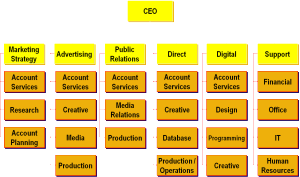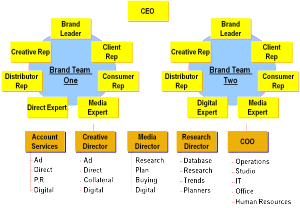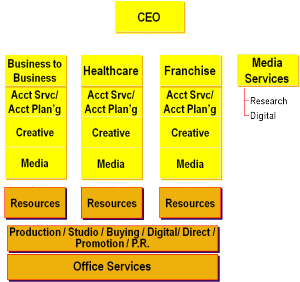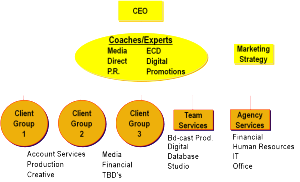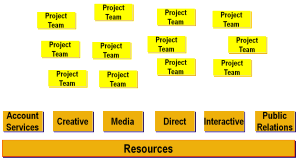Changing the organizational chart does NOT equal operational excellence.
Structure is not the enemy, or the Holy Grail – it is only a tool that supports the brand. Structure provides the foundation for resource management and reconciliation – only! Agencies that are masters in the Art of Operations can work in any “structure.” Operations knowledge, information reporting, metrics and incentives are the key to understanding what structure will work best for your firm. Developing a comprehensive operations strategy is the first step.
Complexities and Issues Associated With Re-Structuring
Approaching a “blank-page” solution as an organizational exercise and should involve all levels of the firm. The business strategy, the work and the process should drive the structure – and it should be clear to staff how and why solutions were developed.
Most re-structuring efforts fail due to top-down solutions – not gaining the involvement and support of managers and staff. The agency leaders start with inflated expectations on the expected results and will attempt whole scale change by supremacy of their position. They didn’t approach the change as an evolutionary process where the solutions are developed organically. Most of the time the agency leadership fails to understand, or think-through, the myriad of new issues that are created – often resulting in creating a larger mess where the staff is confused, key talent ends up leaving and much of the agency energy is absorbed into non-value added activities.
The flipside to this top-down solution is what we call Analysis Paralysis. Leaders end up spending too much time thinking instead of testing/acting.
To create an effective Operating Strategy you need not just management commitment, but support from the staff as well. This ensures resources, decisions, momentum are maintained throughout the change process.
Leadership must have a clearly articulated vision for the firm, and the mission, goals and objectives have to be tangible and understood by all levels of the organization. The role of leaderships should be to motivate and energize the staff and the goals have to be achievable. Simply claiming that you will be the “Best Creative Agency in the World” is not enough.
By incorporating all operational components and organizational levels the staff will take ownership of the change. Leaders and change agents (proactive members of the staff at all levels) will be actively engaged.
When thinking about your operational strategy you need to closely examine:
- Types of client(s) being serviced
- What do you say you do …
- What are you known for …
- Relative role/power of functions in the agency (e.g. account service vs. creative)
- Depth and breadth of resource pool
- Systems for information availability
- Proximity (staff, offices, clients)
Revisiting Your Operational Strategy Can Have Dramatic Results
Our clients have realized tangible results in profitability, productivity and employee morale. On a larger scale, we have successfully designed and implemented new organizational structures, created long-term systems strategies, streamlined work processes by 30% to 50% and created the forms and tools to support process improvements. More narrowly focused projects have included designing a production billing system, moving a creative production process from manual to electronic-based, and improving employee productivity.
Sanders Consulting Group has identified five primary types of organization structures in the marketing communications industry.
The 5 Ad Agency Organizational Structure Alternatives:
1. Traditional
Key Success Factors
- No Politics – Professional Managers
- Complimentary Business + Financial Objectives
- Process Discipline
When Appropriate
- Large, Separately Branded Divisions
- Little Cross-Client Sharing
- Client Manages MC Partner Selection
Issues Addressed
- Clear Lines of Authority / Control
- Good Career Path Definition /Opportunities
- Focus on Best-of-Breed Capabilities
Issues Created
- Agency First – Client Needs Second
- Separate / Redundant Functions
- Maintaining Strong Professional Attitude and Definition
2. Integrated
Key Success Factors
- High-end Talent
- Credible / Subservient Functions / Departments
- Effective / Generous Compensation Schemes
When Appropriate
- Client Wants / Values I.M.C. / Brand Service
- Large, Complex Accounts (and Stable)
- One Look / Voice More Important Than Execution
Issues Addressed
- Breaks Down Divisional Barriers
- ‘Right’ / Best MC Plans Created
- Intimate Client Relationship
Issues Created
- Conflicting Leadership / Priorities with Departments
- Maintaining High Executional Performance
- Balance Between Strategy and Tactics
3. Specialized
Key Success Factors
- Recognized Talent / Capabilities Across MC Discipline
- Maintaining Focus
- Balancing Central / Decentral Functions
When Appropriate
- Complex Industries / Markets Served
- Different MC Requirements Across Specialties
- Specialized Talents Available
Issues Addressed
- Consistent Thinking and Work Produced
- Clearly Defined Leadership Priorities
- Use Only Needed Resources
Issues Created
- Developing Proprietary Capabilities
- Heavy Leadership / Talent Investment
- Effective Utilization of Shared Resources
4. Delivery (or team-based)
Key Success Factors
- Matching Work With Capabilities
- Developing Appropriate Culture / Career Paths
- Balancing Strategy with Executional Orientation
When Appropriate
- Stable, Well Defined Clients / Work
- High Volume / Quick Turnarounds
- Tight Economics
Issues Addressed
- Reduced Politics / Focused Priorities
- Client at Center
- Entrepreneurial / Motivating
Issues Created
- Maintaining Specialization and Career Focus
- Cross Fertilization and Utilization of ‘Best’ Resources
- Short Term Orientation
5. Virtual
Key Success Factors
- High End / Motivated Talent
- Flexible Delivery Mechanisms
- Tools and Environment
When Appropriate
- Short, High-Impact Programs
- Availability of Excellent Sub-Contractors
- Few Luminaries Sought By Client
Issues Addressed
- Flexibility Spontaneity
- Energetic, Fluid Environment
- Leadership Positions Based on Performance
Issues Created
- Resource Availability and Conflicts
- Follow Through on Execution
- Managing Agency Economics
The objective is always to create a smooth running operation inside the agency. The operational strategy should represent the translation of the firm’s strategic vision into the internal business practices, processes, people and structure that will be needed to achieve the vision. Our experience in the industry has helped us clarify the critical components of a creative services firm’s operational strategy to position it for future challenges. If you would like to learn more please give us a call at 412.897.9329 or email us at [email protected]


